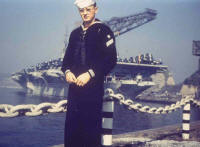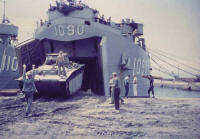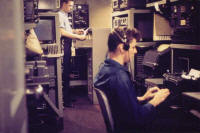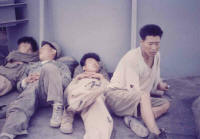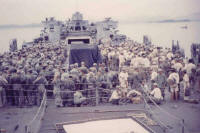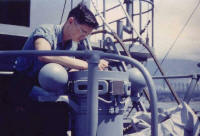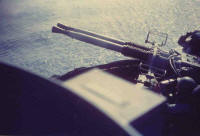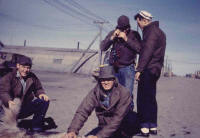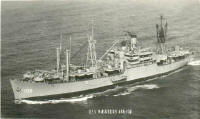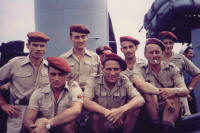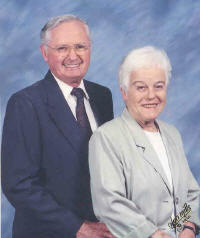|
We need your help to keep the KWE online. This website
runs on outdated technology. We need to migrate this website to a modern
platform, which also will be easier to navigate and maintain. If you value this resource and want to honor our veterans by keeping their stories online
in the future, please donate now.
For more information, click here.
|
|||||||||||||||
 |
|||||||||||||||
| Back to "Memoirs" Index page | |||||||||||||||
|
|
George Wayne CurtisChampaign, Illinois- "I did navigation chart work, and then also, we had to learn and use semaphore and use the flashing lights and so fourth. I was kind of a cross between that and a signalman." - George Wayne Curtis
|
||||||||||||||
|
From an edited interview on September 30, 2003 with Charles Knox I was born in Champaign in 1931. I went into the Navy in January, 1951. My Boot Camp was at Great Lakes. Boot Camp was challenging. We had many different classes. By that I’m talking about school classes that we had to go through on gunnery and do a lot of work along this line. The biggest thing I sure remember there, it was cold as Hades. Not Hades hot, Hades cold. I went in right on the 3rd of January. It was a cold winter. I mean it was cold! Being out there on the old hard top marching and things, it wasn’t all that fun. But we survived it. I was in Recruit Company 21. It was fine.
During my enlistment I served in the Naval Amphibious Forces on the following ships: USS Andromeda AKA 15, USS LST 1090, USS Washburn AKA 108 and USS LST 772. At that point we were really trained on landings. We didn’t have troops of any significance. The 1090 was in the follow-up behind the initial landings in Inchon. One of my duties was navigation and assist in trying to get into the channel at Inchon. It is treacherous, particularly because you could only get in that channel at certain times because of the high tide, and that tide is very high. It’s the highest in the world.
We did have some Marines that were cut off at Inchon. They directed us then to come in with the LST and beach it to get them. I think there were 8 Marines. We had to get them out because the Koreans were coming down on them. The LST came in and dropped the stern anchor and beached to pick them up. We picked them up and backed off and went on down the river. We picked up prisoners of war at Inchon and then we would take them down to Koje-do Island which is a compound for prisoners. It is a big island and that was quite a monumental task. There were several hundred prisoners on board each trip. We did have to feed them because it was quite some distance from Inchon down to Koje-do. A day or two sail. We had hooked up on the ship the sort of a pot like a 55-gallon drum to feed them rice. We would use steam hoses hooked to a long sort of a pipe, and stick that down in the rice and then stir it and cook it and it worked fine. The prisoners were carried on the main deck. We also carried some war criminals. We brought them back separately. They were actually separated from the other Korean prisoners and the Chinese prisoners. They were criminals that had decapitated 6 Americans.
When we got down to the prison camp we off loaded them by using the LCVP’s. The LCVP’s were dropped down and then they would run a load to the beach. As I recall, the prisoners went over the side and climbed down landing nets to get in the LCVP. They would be taken up to the compound.
After the armistice in 1953 we delivered prisoners from the compounds to Pusan. Some did not want to be repatriated. They refused to come out of the compounds and that became a problem. So, what they had to do was to gas them with hand grenades in order to get them out of the compounds. We had to drag them out. When we got to the repatriation point, I don’t really recall they gave us a hard time once we got up there, they had to go and they got dumped.
Shortly after this I was transferred to the USS Washburn. She was an AKA Auxiliary Cargo Attack ship. We made a trip to Point Barrow, Alaska. That was done in the summer time. The trip was made once a year to bring in fuel oil and supplies to last a year. We loaded in California then we went up to Washington and loaded on the rest of the cargo. We were in company with the USS Skaggett bringing in supplies. The trip going up was very enjoyable. Right along side of our ship, were whales. They were coming along side and we were close to them where we could see them breaching and blowing water. And that was quite interesting. Then going on going up we passed Big Diomede and Little Diomede, that’s the divide of the boundaries between Russia and Alaska. As we continued on north we had to make an emergency anchorage for a while. The icebergs were coming down; we had to anchor for a day before continuing our voyage.
When we got to Point Barrow it took about 3 days to unload. We had to hurry in offloading as we just had a window of a few weeks before we would get iced in as the Arctic winter returned. We were anchored out from Point Barrow. We were about 10 miles away. We had cranes aboard the Washburn and the Skaggett that could hoist those oil drums and then they would lower them down into the LCVP’s to make their run to the beach. I was assigned to Shore Patrol. I was on the beach and spent some time there with the Eskimos who were very nice. The Navy took up crates of oranges and food to give to the Eskimos. This was one of the highlights of the year for the Eskimos. While I was on shore patrol I met a young lady. She was from Michigan and she had just been transferred, moved up there as a school teacher. I recall that she was a lovely lady. This was going to be her first winter up there. When we off loaded all the oil and everything, the sailors would play baseball with the Eskimos and that was quite a treat for them. What was so beautiful about the trip was after we were all finished, little babies, the Eskimos, whole families would come down to the beach to see us off. That was a treat for them and us. When it was all over with and we were ready to pull off the beach all the Eskimos lined up and started to sing to us. They were all smiling and waving and singing as were pulling off of the beach. That was touching. Following the Barrow trip I transferred to LST 772. We went to Korea and then to French Indochina where we were to evacuate French troops and civilians from what ended up being North Viet Nam. We were on our way down to French Indochina but we stopped in Hong Kong. On one of the days we were in Hong Kong, almost all of us woke up sick at one time. We had got some vegetables from the English and they gave us all dysentery. And, boy oh boy, everybody was on the throne. Seating was at a premium. While we were in Hong Kong I met a beautiful girl. She was Portuguese from Macau, the Portuguese enclave close to Hong Kong. We had a good time as sailors and pretty young girls will in any port of call.
From Hong Kong we went to Indochina to the port of Haiphong. We had a month to get them out. We took some of them to Da Nang further down the coast in what was South Viet Nam. Sometimes we would go up stream from Haiphong towards Hanoi to pick up refugees. We picked up French Paratroopers and French Foreign Legion soldiers. After we got loaded each time we took our passengers south. When we were coming south we threw overboard a lot of guns such as rifles and things of this nature. We also took a lot of native civilians that worked for the French or were French dependents that lived in that area. We went to Da Nang, I always remember that we brought aboard civilians after we got the military. One time when we were bringing these refugees aboard there was this one lady, she was in labor and we had built a birthing room on the LST behind a curtain and that’s where that child was born. We went to Saigon once. I’ll never forget when I went over there I was hungry and we got separated there. This fellow who had been a Navy man was French. He had been to our country back in the ‘30’s. One thing lead to another and he a fixed a meal for us. He fed us a sandwich or something. I’ll never forget one thing and that was the meat. It was horrible. Could have been somebody’s dog, it was dead. Anyway we were coming back and I was due to be discharged. We went through the Philippines. We were docking in Manila. The Skipper was a bullheaded type. He knew everything. The Captain was coming right along side of this ship and our ship’s davits, that held the landing craft, were still swung outboard. We tried to get it to him, that the davits were still swung outboard He didn’t pay any attention. We stood right there, we had to, its all we could do is stand there. Boy, he side-swiped that tanker and he just tore that davit just flat. I flew back to the state in November and entered the University of Illinois for the spring semester of 1954.
While at the University I met my wife, Martha Monical. Martha was Dr. Shongert’s nurse and he was my doctor. I would go in there for Polio shots. And Martha’s a pretty little girl, just a cute little thing. I got real interested in her. When I first saw her I thought she’s a pretty little thing. There was an older nurse in the office and she kind of knew I had my eye on Martha. Anyway, I had 3 shots for Polio and I had a cold and I had gotten a couple shots for that. After 1 year and 7 shots we had our first date. Martha always comes back at me that when her father was introduced to me, Walt, Martha’s father, said "What took him so long." After 7 shots in a year, we had our first date. I graduated from the University and stayed on in the Geological Survey. Martha and I were married. We continue to live in Champaign. It has been a good life. |
|||||||||||||||
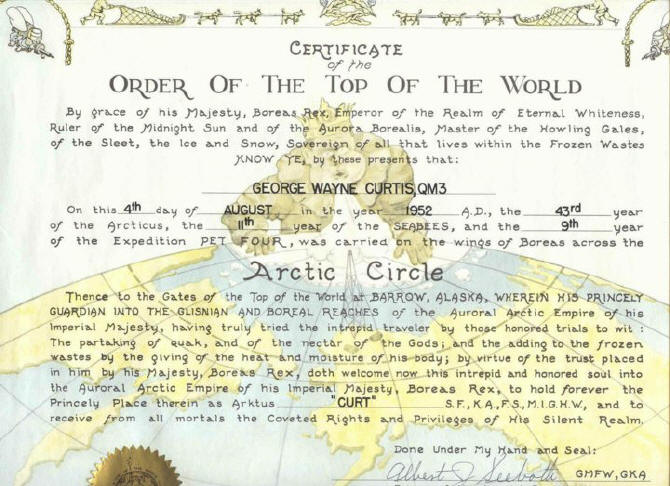 |
|||||||||||||||
|
|||||||||||||||
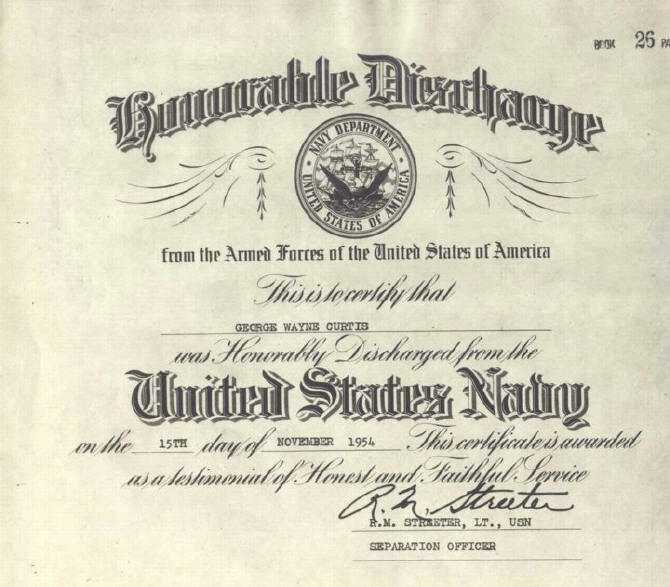 |
|||||||||||||||
|
|||||||||||||||
 |
|||||||||||||||


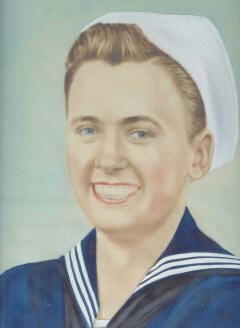
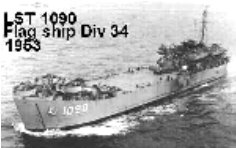 When I graduated the Navy called the shots on assignment.
When we got out of boot camp we were broken up to distribute to the fleet. I was sent to San Diego. When we got to
San Diego we had a little more training. Then I went from there to the USS Andromeda over seas to Japan. When we
were in Japan, we were there for a number of days. We got to see a lot of things right there in Japan. We were in
the barracks and we had our meals and everything there. It was our stepping stone from coming over from the States
to fleet assignments. I was sent to Yokasuka and assigned to the LST 1090. The 1090 was my main ship. I made
Quartermaster 3rd Class on the 1090. I did navigation chart work, and then also, we had to learn and use semaphore
and use the flashing lights and so fourth. I was kind of a cross between that and a signalman. In World War II
they were split, but in a Korea, where we were, they had consolidated rates. When I was on the 1090 we actually
got some more training down in Pusan area, on loading, off loading, tanks, and the LCVP’s. The LCVP, that’s what
we would use when we would go ashore.
When I graduated the Navy called the shots on assignment.
When we got out of boot camp we were broken up to distribute to the fleet. I was sent to San Diego. When we got to
San Diego we had a little more training. Then I went from there to the USS Andromeda over seas to Japan. When we
were in Japan, we were there for a number of days. We got to see a lot of things right there in Japan. We were in
the barracks and we had our meals and everything there. It was our stepping stone from coming over from the States
to fleet assignments. I was sent to Yokasuka and assigned to the LST 1090. The 1090 was my main ship. I made
Quartermaster 3rd Class on the 1090. I did navigation chart work, and then also, we had to learn and use semaphore
and use the flashing lights and so fourth. I was kind of a cross between that and a signalman. In World War II
they were split, but in a Korea, where we were, they had consolidated rates. When I was on the 1090 we actually
got some more training down in Pusan area, on loading, off loading, tanks, and the LCVP’s. The LCVP, that’s what
we would use when we would go ashore.